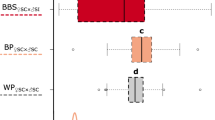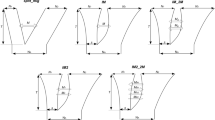Abstract
THE S locus governing gametophytic self-incompatibility in plants is particularly suited to mutation studies. Pollen grains having an unmutated allele are unable to grow through a style carrying the same allele. In contrast ‘mutant’ grains produce pollen-tubes which may overcome the incompatibility barrier. Thus, mutation can be scored simply as seeds produced in normally sterile matings, and then subjected to confirmation by progeny phenotypes. Studies of S locus mutations have been confined to heterozygous plants2–4 as homozygotes are difficult to obtain in many species. Since pollen S phenotype is a gametophytic character, it has been implied that mutation frequencies of alleles in homozygous plants would simply reflect those of alleles in the corresponding heterozygotes. The present study does not support this postulate.
This is a preview of subscription content, access via your institution
Access options
Subscribe to this journal
Receive 51 print issues and online access
$199.00 per year
only $3.90 per issue
Buy this article
- Purchase on Springer Link
- Instant access to full article PDF
Prices may be subject to local taxes which are calculated during checkout
Similar content being viewed by others
References
Brewbaker, J. L., J. Hered., 48, 271 (1957).
Lewis, D., Heredity, 3, 339 (1949).
Lewis, D., Heredity, 5, 399 (1951).
Pandey, K. K., Genetics, 41, 327 (1956).
Author information
Authors and Affiliations
Rights and permissions
About this article
Cite this article
BREWBAKER, J., SHAPIRO, N. Homozygosity and S Gene Mutation. Nature 183, 1209–1210 (1959). https://doi.org/10.1038/1831209a0
Issue Date:
DOI: https://doi.org/10.1038/1831209a0
This article is cited by
-
The effects of different mutagens on self-incompatibility in Nicotiana alata Link and Otto
Heredity (1975)
-
Breaking breeding barriers in Lycopersicon. 2. Breakdown of self-incompatibility in L. peruvianum (L.) Mill.
Euphytica (1972)
-
Time and site of theS-gene action, breeding systems and relationships in incompatibility
Euphytica (1970)
-
Elements of the S-gene complex II. Mutation and complementation at the SI locus in Nicotiana alata
Heredity (1967)
-
Self-compatibility in hybrids between Phureja and haploid Andigena clones ofSolanum tuberosum
European Potato Journal (1964)
Comments
By submitting a comment you agree to abide by our Terms and Community Guidelines. If you find something abusive or that does not comply with our terms or guidelines please flag it as inappropriate.



